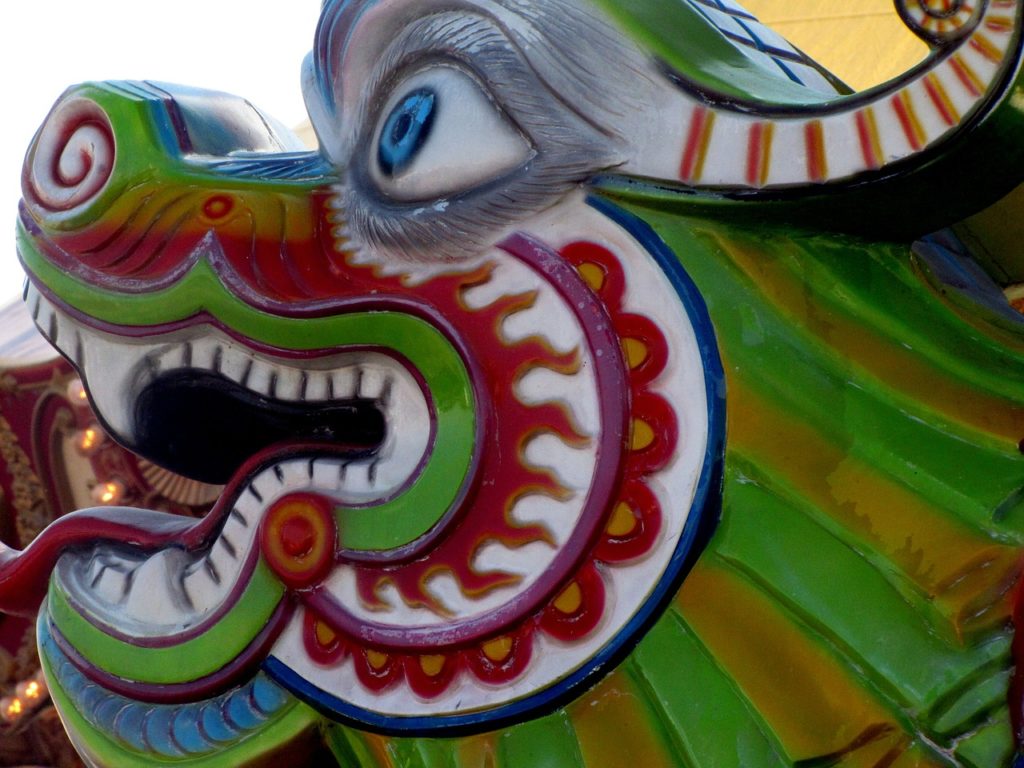
I wrote this piece in 2009 on the blog of a podcast that I used to do (and that no longer is online). This piece of writing is about real events that happened decades ago, at my first job.
The amusement park I worked at hired teenagers, and didn’t put much effort into training them before handing them the keys to one of the rides. This amusement park closed a long time ago – and then reopened under a new owner.
I read “The Dragon is on Fire” in episode 038 of my Words of Jen podcast.
My very first job was at a local amusement park that had a secular Christmas theme. There were Christmas trees, and a spinning ride where the carts were made to look like snowballs. Kids could get their picture taken with Santa at “Santa’s House” in the middle of summer.
I was fifteen years old, which meant I was old enough to have a work permit, but too young to run an amusement park ride unsupervised. There were several different areas of the park that hired local teenagers. I cannot remember why I thought working as a ride operator would be cool.
The experience I had as a ride operator at this amusement park was enough to scar me for life. Since then, I am afraid to go on rides at carnivals or amusement parks, because I’ve seen what can happen when (mostly) untrained (mostly) teenage workers are left to run rides that haven’t been properly maintained.
Things caught fire. Not everything, of course. The bumper cars were notorious for catching fire, and forcing whatever unfortunate person was in that car to evacuate. Doing so meant dodging around the oncoming bumper cars while fleeing toward safety. It happened on a daily basis.
When I turned sixteen years old, after about a month or so of working at the amusement park, the law no longer required me to work under supervision. The managers didn’t give anyone much training before leaving them to run a ride by themselves all day long. Training often consisted of: “Here’s the keys. The keys go in there, and you turn the key this way to turn on the ride. That button is the brake. Make sure ya time it right.”
Some of the rides no longer had functioning brakes. Managers would sometimes point that out to workers, but not always. I distinctly remember a manager telling me that a ride, that was designed for toddlers and small children, no longer had brakes. The ride had cars that lifted off the ground while spinning in a circle.
There were no seatbelts on this ride. If it looked like a little kid was about to stand up, while the ride was moving, I was instructed to block one of the cars with my body and try and slow it down. I was about five feet tall, and and weighed about 100 lbs.
One day, I was assigned to run the dragon roller coaster. It was one of those small roller coasters designed for little kids to go on. The ride was large enough to accommodate adults, and parents could ride it with their children. The dragon went over a circular track that sort of went up a little bit here, and down a little bit there, before returning to the start.
Once you got the people on, and started the ride, you were supposed to let it go around a few times before stopping it. Ride operators had to time it correctly to get the coaster to stop in front of the part where people could get on and off.
Trying to time it was important because the brakes weren’t entirely reliable. Sometimes, the brakes would activate when you hit the button. Sometimes, the breaks wouldn’t work at all, so you let the people on the ride go around a few more times and then make a second try at engaging the brakes. Often, the brakes would function, but were slow, and the coaster would stop close enough to the landing zone.
We called that “good enough” and started directing people to get off the ride.
So, I was running the dragon coaster ride, all by myself, in the hot sun during a muggy midwestern summer. The majority of my day was spent by myself, guessing about whether or not the brakes would activate this time. There was a moment of panic as I waited to see what would happen after I hit the “stop” button.
One time, the breaks didn’t activate at all… until they tried to. Part of the coaster was situated just fine, which allowed some people to get off the ride. The front part, however, was past the landing zone. Sitting in the first seat were two five-year-old kids, who didn’t appear to have any adults with them at all. They were basically stuck on the ride.
Trying not to freak out the kindergarteners, I tried to give them some instructions. “Um… just stay put for right now,” I told them. “Don’t try and get off the ride.”
The two little kids stared at me, with an astonished look on their faces. Then, they turned to look at each other… and cheered! I breathed a sigh of relief. These two little kids were having a blast and weren’t scared at all about temporarily being stuck on the dragon roller coaster. I didn’t have to worry about them trying to jump off it and maybe breaking a leg.
The next thing I needed to do was call my manager. This was a nearly impossible task. We didn’t have walkie-talkies or any other means of communicating with anyone when we were running a ride.
The best I could do was leave the ride, run into the gift shop that was nearby, and ask a worker to use the gift shop phone to call their manager. My hope was that the gift shop manager, after being told what happened, would have the sense to call the rides manager.
The girl working behind the register rolled her eyes at me, sighed, and called her manager. In the snottiest tone ever, she told the gift shop manager what happened with the dragon roller coaster. After hanging up, she abruptly told me that the gift shop manager was going to contact the rides manager.
I was getting glared at by a register jockey who got to be inside with the air conditioning all day long. Part of me wanted to punch her, but I didn’t have time for that. I dashed back to the dragon roller coaster.
When I returned to the ride, just a couple of minutes later, I faced a line of angry people. Some demanded that I let their kids on the ride – right now – since those two little kids were still on the ride. Many others yelled at me about how long they had to wait in line. Nodding my head at these people, I scooted around them and went back up the stairs to the dragon roller coaster.
Meanwhile, the front part, that was shaped like the head of a dragon, had started to smoke. Not knowing what else to do, I climbed onto the ride, and helped the two five-year-olds over the seat they were sitting on. Little by little, I moved each kid over the next few seats, until they could safely reach the platform.
Immediately after I got the kids off the ride, and down the stairs, flames started shooting out of the dragon roller coaster.
This was when my manager arrived – and he was not pleased.
After glaring at me, he turned around and attempted to dispel the crowd. The air was thick with smoke, and the flames coming out of the dragon had gotten higher. Despite this, there were people who were arguing with the rides manager and demanding to get on the ride. As if the time they spent waiting in line was going to magically extinguish the fire.
The manager stormed past me and marched up the stairs to the dragon roller coaster. I quickly put up the chain that blocked people from getting on the ride. It would at least stall them, I figured, knowing full well that someone was going to show up and be completely mystified about why the ride was out of service.
When I turned around, the rides manager started yelling at me. “This is your fault! You didn’t follow my directions about properly timing the brakes!” I responded, equally loudly, “Maybe you should have stuck around to actually teach me that. You knew that the brakes on the dragon don’t work all the time!”
Surprisingly, this did not get me fired. It was not unusual for rides to have brake problems, to malfunction, or to start smoking. He knew I was right, but wouldn’t admit it. Instead of fighting with me, the rides manager got on his walkie-talkie and called a second rides manager.
The only thing I could do now was get out of the way. The second rides manager arrived and stared dumbly at the roller coaster. He probably wasn’t expecting to see the dragon actually breathing smoke and fire.
Eventually, amidst lots of cursing, the two rides managers were able to get the dragon roller coaster to stop burning. The ride was closed for the rest of the day.
Why did this happen? It was because the brakes didn’t work and no one knew how to fix them. The brakes on the dragon roller coaster consisted of two pieces of metal that closed over the track when you hit the stop button. Or, at least, that’s what they should have done.
When I hit the stop button, one side of the brakes did what it was supposed to do, while the other side failed to close over the track. So, the dragon was trying to stop, and keep going, at the same time. On this hot and humid day, in the middle of a muggy midwestern summer, the dragon breathed fire.
If you enjoyed this blog post please consider supporting me at on Ko-fi. Thank you!

One comment